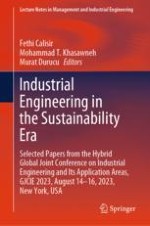2024 | Buch
Industrial Engineering in the Sustainability Era
Selected Papers from the Hybrid Global Joint Conference on Industrial Engineering and Its Application Areas, GJCIE 2023, August 14–16, 2023, New York, USA
herausgegeben von: Fethi Calisir, Mohammad T. Khasawneh, Murat Durucu
Verlag: Springer Nature Switzerland
Buchreihe : Lecture Notes in Management and Industrial Engineering
